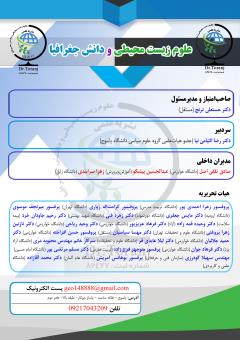ارتباط بلوغ سازمانی و سرآمدی سازمانی در کارکنان در آموزش و پرورش استان کهگیلویه و بویراحمد
محورهای موضوعی : علوم برنامه ریزی
1 - علمی کاربردی یاسوج
کلید واژه: بلوغ, بلوغ فردی, بلوغ فرایندی و بلوغ سازمانی, سرآمدی سازمانی, آموزش و پرورش,
چکیده مقاله :
هدف پژوهش حاضر بررسی رابطه ی بررسی رابطه ی بین بلوغ سازمانی و سرآمدی سازمانی کارکنان در آموزش و پرورش استان کهگیلویه و بویراحمد در سال1400 بود. روش تحقیق، روش توصیفی-همبستگی و نوع پژوهش با توجه به هدف تحقیق کاربردي بود. جامعه ی آماری این پژوهش شامل کارکنان سازمان آموزش و پرورش استان کهگیلویه و بویراحمد بود که با استفاده از نمونه گیری تصادفی متناسب با حجم تعداد 100 نفر انتخاب گردید. ابزار جمع آوری اطلاعات پرسشنامه ی محقق ساخته ی بلوغ سازمانی بود که سه بعد بلوغ فردی،بلوغ فرایندی و بلوغ سازمانی را مورد اندازه گيري قرار گرفت. پرسشنامه ی محقق ساخته ی دوم سرآمدی سازمانی را مورد سنجش قرار داد. به منظور تعیین روایی پرسشنامه ها از روش صوری و محتوایی استفاده شد. چند مرتبه متوالی در اختیار اساتید متخصص،علوم تربیتی،روانشناسی تربیتی و مدیریت منابع انسانی قرار گرفت که در هر مرحله اصلاحات پیشنهادی لازم در پرسشنامه اعمال گردید. پایایی پرسشنامه ی بلوغ سازمان و سرآمدی سازمانی با استفاده از ضریب آلفای کرونباخ 97% و 93% تعیین گردید که نشان دهنده ی پایایی مناسب ابزار اندازه گیری بود. پس از جمع آوری داده ها،تجزیه و تحلیل آن ها در دو سطح توصیفی و استنباطی با استفاده از نرم افزار SPSS انجام شد. در سطح توصیفی مشخصه های آماری نظیر فراوانی، درصد،میانگین،انحراف معیار و در سطح استنباطی متناسب با سطح داده ها و فرضیه ها،آزمون های آماری تی استیودنت،ضریب همبستگی پیرسون،رگرسیون، آزمون تحلیل واریانس یک راهه مورد استفاده قرار گرفت. نتايج اين فرضيه نشان داد که سطح بلوغ کارکنان و سرآمدی سازمانی در سازمان آموزش و پرورش در سطح مطلوبی قرار دارد و هم چنین بین تمام مولفه های بلوغ سازمانی که شامل بلوغ فردی،بلوغ فرایندی و بلوغ سازمانی است با شاخص های سرآمدی سازمانی رابطه ی مثبت و معنی داری وجود دارد.اصلی ترین یافته این پژوهش این است که بین سن بلوغ فردی وسازمانی وسرآمدی سازمانی در آموزش و پرورش رابطه وجود دارد.
The purpose of the present study was to investigate the relationship between organizational maturity and organizational excellence of employees in education and training in Kohgiluyeh and Boyer Ahmad provinces in 1400. The research method was the descriptive-correlation method and the type of research according to the purpose of the research was applied. The statistical population of this research included the employees of the education and training organization of Kohgiluyeh and Boyer Ahmad provinces, which were selected using random sampling proportional to the number of 100 people. The tool for collecting information was a researcher-made organizational maturity questionnaire that measured the three dimensions of individual maturity, process maturity and organizational maturity. The researcher's second questionnaire measured organizational excellence. In order to determine the validity of the questionnaires, formal and content methods were used. It was provided to expert professors, educational sciences, educational psychology and human resource management several times in a row, and the necessary proposed amendments were applied in the questionnaire at each stage. The reliability of organizational maturity and organizational excellence questionnaire was determined using Cronbach's alpha coefficient of 97% and 93%, which indicated the appropriate reliability of the measurement tool. After collecting the data, their analysis was done at two descriptive and inferential levels using SPSS software. At the descriptive level, statistical characteristics such as frequency, percentage, mean, standard deviation, and at the inferential level according to the level of data and hypotheses, statistical tests of Student's t, Pearson's correlation coefficient, regression, and one-way analysis of variance were used. The results of this hypothesis showed that the level of maturity of employees and organizational excellence in the education organization is at a favorable level, and also there is a positive relationship between all the components of organizational maturity, which include individual maturity, process maturity and organizational maturity, with indicators of organizational excellence. And there is significance. The main finding of this research is that there is a relationship between individual and organizational maturity and organizational efficiency in education.
ايزدي يزدان آبادي، احمد .( 1385 ). بررسي رابطه بين ويژگي هاي ساختار سازماني و سطح بلوغ كاركنان صف و ستاد دانشگاه تربيت معلم و ارائه الگوي ساختاري مناسب، دانشكده روانشناسي و علوم تربيتي، دانشگاه تربيت معلم تهران.
بخشي، جواد. محمد، نايبي.قنبر، محمدي الياسي.( 1385 ). تعيين سطح بلوغ قابليت هاي منابع تهران : مجموعه .P-CMM انساني شركت هاي سازنده قطعات خودرو بر اساس الگوي مقالات هفتمين كنفرانس بين المللي مديران كيفيت.
پناهیان حسین ؛ پناهیان، محمدرضا (1384). طراحی و استقرار مدل تعالی سازمانی بر اساس روش EFQM .فصلنامه بصیرت،36:29-8
پیترز، تام. ریچارد واترمن 1372). به سوي بهترین ها سیماي شركت ها و سازمان هاي موفق ، ترجمه م قراچه داغی، چاپ اول، تهران : هم آگاه .


